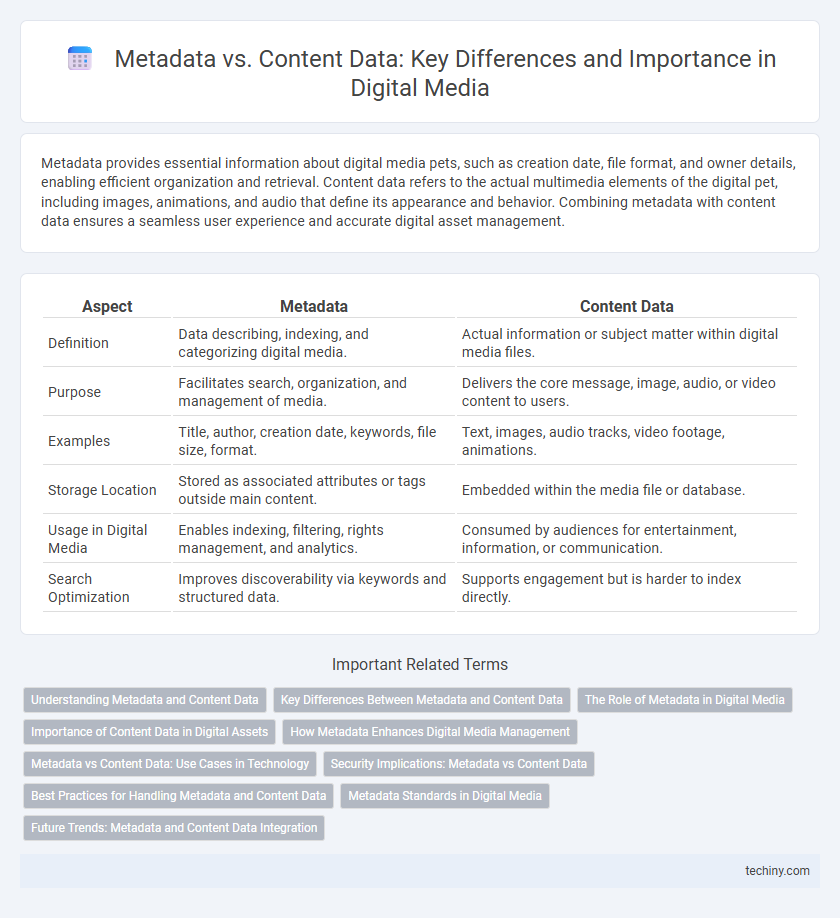Metadata provides essential information about digital media pets, such as creation date, file format, and owner details, enabling efficient organization and retrieval. Content data refers to the actual multimedia elements of the digital pet, including images, animations, and audio that define its appearance and behavior. Combining metadata with content data ensures a seamless user experience and accurate digital asset management.
Table of Comparison
| Aspect | Metadata | Content Data |
|---|---|---|
| Definition | Data describing, indexing, and categorizing digital media. | Actual information or subject matter within digital media files. |
| Purpose | Facilitates search, organization, and management of media. | Delivers the core message, image, audio, or video content to users. |
| Examples | Title, author, creation date, keywords, file size, format. | Text, images, audio tracks, video footage, animations. |
| Storage Location | Stored as associated attributes or tags outside main content. | Embedded within the media file or database. |
| Usage in Digital Media | Enables indexing, filtering, rights management, and analytics. | Consumed by audiences for entertainment, information, or communication. |
| Search Optimization | Improves discoverability via keywords and structured data. | Supports engagement but is harder to index directly. |
Understanding Metadata and Content Data
Metadata in digital media refers to descriptive information that provides context about content data, such as tags, author details, creation date, and file format. Content data represents the actual media elements including images, videos, audio, and text that users consume and interact with. Understanding the distinction between metadata and content data is essential for effective organization, searchability, and management of digital assets.
Key Differences Between Metadata and Content Data
Metadata in digital media describes information about the content, such as file size, creation date, author, and format, enabling efficient organization and retrieval. In contrast, content data refers to the actual media itself, including text, images, audio, and video that convey the primary message or subject matter. Key differences lie in metadata's role for indexing and management, while content data functions as the core material consumed by users.
The Role of Metadata in Digital Media
Metadata in digital media provides essential context by describing content attributes such as file type, creation date, author, and usage rights, enabling efficient organization and retrieval across platforms. This structured data improves search engine optimization (SEO) by enhancing content discoverability and tailoring user experiences through personalized recommendations. Effective metadata management supports copyright enforcement and analytics, making it a critical component in digital media workflows.
Importance of Content Data in Digital Assets
Content data encompasses the actual information and multimedia elements within digital assets, such as images, videos, and text, making it essential for user engagement and value creation. Unlike metadata, which provides descriptive and structural details, content data drives the core experience and functionality of digital media platforms. Emphasizing content data optimization ensures higher relevance, improved searchability, and enhanced user interaction in digital ecosystems.
How Metadata Enhances Digital Media Management
Metadata provides essential context by describing digital media files through attributes like date, author, and format, enabling efficient search and retrieval. It organizes vast amounts of content data, facilitating seamless categorization and improved user accessibility in digital asset management systems. Enhanced metadata integration boosts content discoverability and optimizes workflow automation for media professionals.
Metadata vs Content Data: Use Cases in Technology
Metadata plays a crucial role in digital media technology by organizing, categorizing, and enabling efficient search and retrieval of content data such as images, videos, and audio files. Content data represents the actual media or information consumed by users, whereas metadata provides descriptive, structural, and administrative information that facilitates content management systems, digital asset management, and recommendation algorithms. Use cases include enhancing user experiences through personalized content delivery, improving content discoverability, and supporting automated indexing and archiving workflows.
Security Implications: Metadata vs Content Data
Metadata contains sensitive information about digital media files, such as creation date, location, device details, and user interactions, making it a significant target for privacy breaches and data mining attacks. Content data represents the actual media, such as images, videos, or audio, and its unauthorized access can lead to copyright infringement and intellectual property theft. Securing metadata requires strict access controls and anonymization techniques, while protecting content data necessitates encryption and DRM (Digital Rights Management) technologies to prevent unauthorized distribution and manipulation.
Best Practices for Handling Metadata and Content Data
Effective management of metadata and content data is essential for optimizing digital media workflows and enhancing searchability. Metadata should be standardized, consistently tagged, and regularly updated to ensure accurate categorization, while content data requires secure storage, proper encryption, and structured organization to maintain integrity and accessibility. Implementing automated metadata extraction tools alongside robust content management systems facilitates efficient data handling and supports scalable digital asset management strategies.
Metadata Standards in Digital Media
Metadata in digital media refers to structured information describing content attributes such as creator, format, and rights, enabling efficient organization and retrieval. Content data encompasses the actual audio, video, or text elements, while metadata standards like Dublin Core, MPEG-7, and IPTC ensure interoperability and consistency across platforms. Adherence to these standards supports seamless content management, enhances search accuracy, and facilitates rights management in digital media ecosystems.
Future Trends: Metadata and Content Data Integration
Future trends in digital media emphasize the seamless integration of metadata and content data to enhance content discoverability, personalization, and analytics. Advancements in AI-driven metadata generation enable real-time tagging and contextual enrichment, bridging the gap between raw content and its descriptive information. This integration drives more efficient content management systems, improved user experience, and data-driven decision-making in media platforms.
Metadata vs Content Data Infographic

 techiny.com
techiny.com